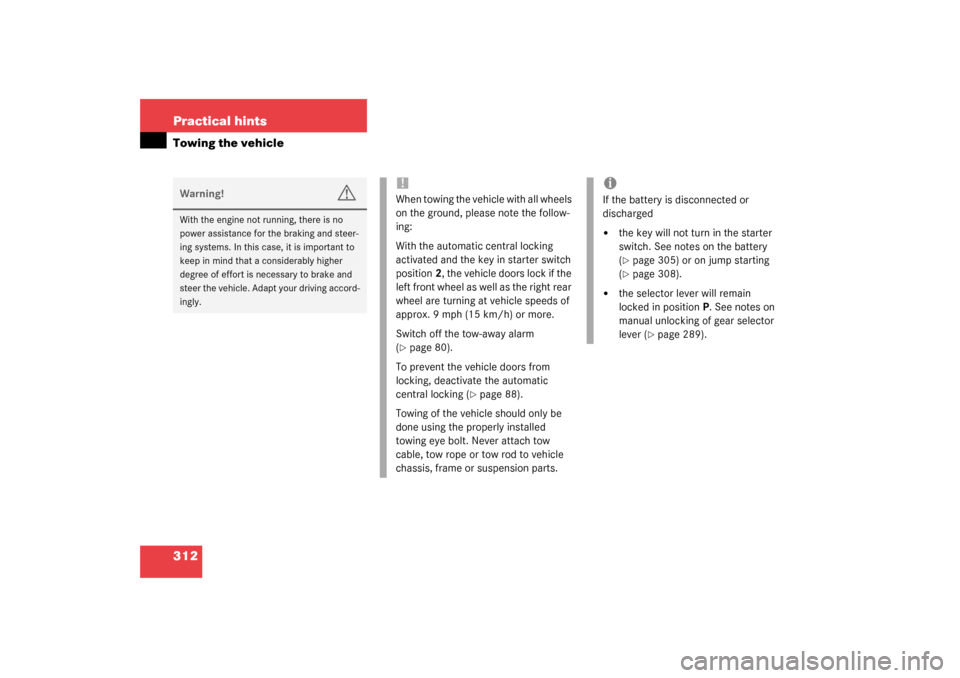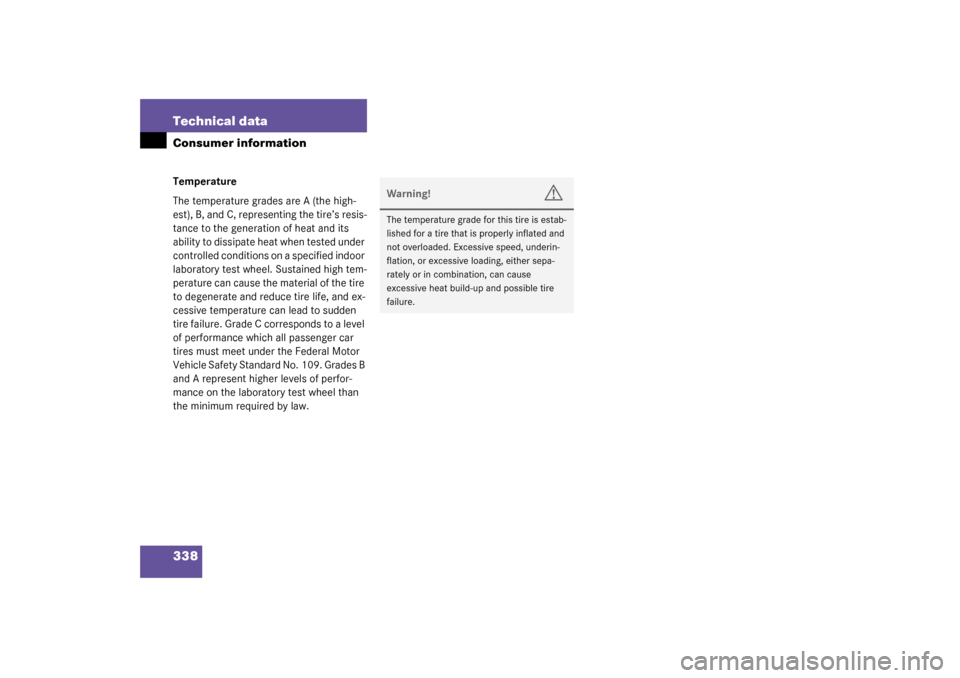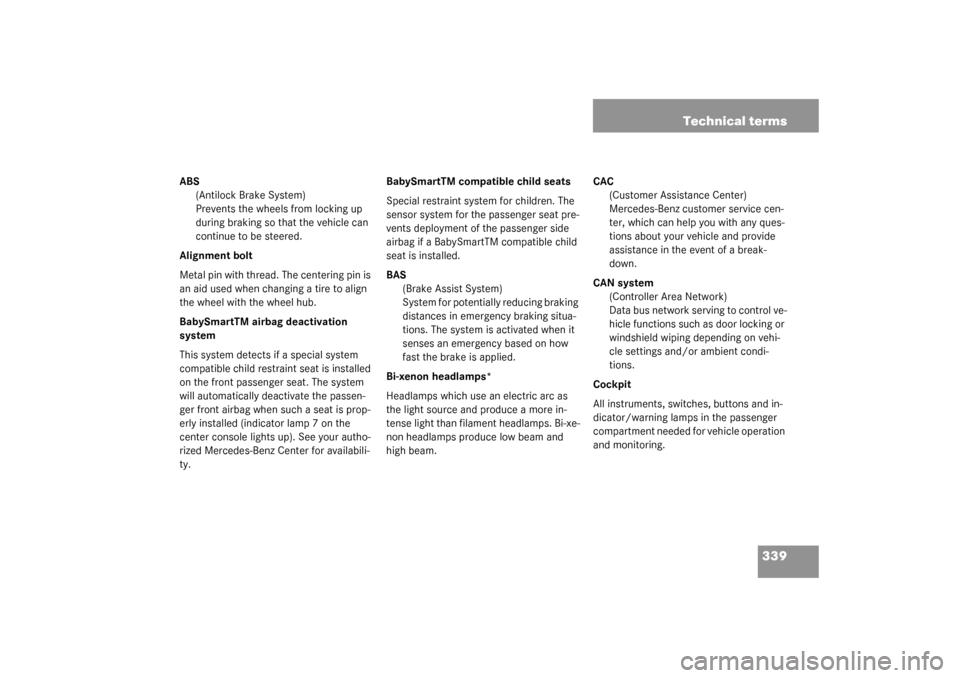Page 306 of 370

312 Practical hintsTowing the vehicleWarning!
G
With the engine not running, there is no
power assistance for the braking and steer-
ing systems. In this case, it is important to
keep in mind that a considerably higher
degree of effort is necessary to brake and
steer the vehicle. Adapt your driving accord-
ingly.
!When towing the vehicle with all wheels
on the ground, please note the follow-
ing:
With the automatic central locking
activated and the key in starter switch
position2, the vehicle doors lock if the
left front wheel as well as the right rear
wheel are turning at vehicle speeds of
approx. 9 mph (15 km/h) or more.
Switch off the tow-away alarm
(�page 80).
To prevent the vehicle doors from
locking, deactivate the automatic
central locking (
�page 88).
Towing of the vehicle should only be
done using the properly installed
towing eye bolt. Never attach tow
cable, tow rope or tow rod to vehicle
chassis, frame or suspension parts.
iIf the battery is disconnected or
discharged�
the key will not turn in the starter
switch. See notes on the battery
(�page 305) or on jump starting
(�page 308).
�
the selector lever will remain
locked in positionP. See notes on
manual unlocking of gear selector
lever (
�page 289).
S203 MY03_A.book Page 312 Tuesday, January 28, 2003 2:22 PM
Page 317 of 370

323 Technical data
Rims and Tires
Rims and Tires
Use only tires and rims which have been
specifically developed for your vehicle and
tested and approved by Mercedes-Benz.
Other tires and rims can have detrimental
effects, such as�
poor handling characteristics
�
increased noise
�
increased fuel consumption
Same size tires
!Moreover, tires and rims not approved
by Mercedes-Benz may, under load, ex-
hibit dimensional variations and differ-
ent tire deformation characteristics
under load that could cause them to
come into contact with the vehicle
body or axle parts. Damage to the tires
or the vehicle may be the result.
iFurther information on tires and rims is
available at any authorized
Mercedes-Benz Center. A tire inflation
pressure table is located on the fuel fill-
er cap of the vehicle. The tire pressure
should be checked regularly and
should only be adjusted on cold tires.
Follow tire manufacturer’s mainte-
nance recommendation included with
vehicle.
C 240
C 320
C 240 4MATIC
C 320 4MATIC
Rims (light alloy*)
7J x16 H2
7J x16 H2
Rims (steel – Canada only)
7J x16 H2
Wheel offset
1.46 in (37 mm)
1.46 in (37 mm)
All season tires (radial-ply tires)
205/55 R16 91 H
205/55 R16 91 H
Winter tires (radial-ply tires)
205/55 R16 91 H M+S
205/55 R16 91 H M+S
S203 MY03_A.book Page 323 Tuesday, January 28, 2003 2:22 PM
Page 318 of 370
324 Technical dataRims and TiresSpare wheel
Your vehicle is equipped with either a
spare wheel with full size tire or a Mini-
spare wheel.
Spare wheel with full size tire
Minispare wheelRim (steel)
7J x16 H2
Wheel offset
1.46 in (37 mm)
All season tire
(radial-ply tire)
205/55 R16 91 H
Rim (steel)
3.5B x16 H2
Wheel offset
0.67 in (17 mm)
Tire
T 125/90 R 16 B98
1
1Must not be used with snow chains.
S203 MY03_A.book Page 324 Tuesday, January 28, 2003 2:22 PM
Page 320 of 370
326 Technical dataMain Dimensions
Main DimensionsModel
C 240
C 240 4MATIC
C 320
C 320 4MATIC
Overall vehicle length
178.9 in (4 543 mm)
178.9 in (4 543 mm)
Overall vehicle width
68.0 in (1 728 mm)
68.0 in (1 728 mm)
Overall vehicle height
57.8 in (1 468 mm)
57.6 in (1 462 mm)
Wheelbase
106.9 in (2 715 mm)
106.9 in (2 715 mm)
Track, front
58.8 in (1 493 mm)
58.8 in (1 493 mm)
Track, rear
57.6 in (1 464 mm)
57.6 in (1 464 mm)
S203 MY03_A.book Page 326 Tuesday, January 28, 2003 2:22 PM
Page 322 of 370

328 Technical dataFuels, coolants, lubricants etc.
Fuels, coolants, lubricants etc.Capacities
Vehicle components and their respective lubricants must match. Therefore use only
brands tested and recommended by us.
Please refer to the Factory Approved Service Products pamphlet, or inquire at
your Mercedes-Benz Center.
Model
Capacity
Fuels, coolants, lubricants etc.
Engine with oil filter
C 240
C 320
C 240 4MATIC
C 320 4MATIC
7.9 US qt (7.5 l)
7.9 US qt (7.5 l)
7.4 US qt (7.0 l)
7.4 US qt (7.0 l)
Recommended engine oils
Automatic transmission
8.5 US qt (8.0 l)
MB Automatic Transmission Oil
1
1MB part no. 001 989 21 03 10Manual transmission
1.3 US qt (1.2 l)
MB Manual Transmission Oil
2
2MB part no. 001 989 26 03 10Rear axle
1.2 US qt (1.1 l)
Hypoid gear oil SAE 85 W 90
Front axle
C 240 4MATIC
C 320 4MATIC
0.5 US qt (0.46 l)
Hypoid gear oil SAE 85 W 90
Transfer case
C 240 4MATIC
C 320 4MATIC
approx. 0.62 US qt (0.59 l)
MB Automatic Transmission Oil
1
Power steering
approx. 1.1 US qt (1.0 l)
MB Power Steering Fluid (Pentosin CHF 11S)
Front wheel hubs
approx. 2.1 oz (60 g) each
High temperature roller bearing grease
Brake system
0.5 US qt (0.5 l)
MB Brake Fluid (DOT 4+)
Cooling system
approx. 6.8 US qt (6.4 l)
MB 325.0 Anticorrosion/Antifreeze Agent
S203 MY03_A.book Page 328 Tuesday, January 28, 2003 2:22 PM
Page 332 of 370

338 Technical dataConsumer informationTemperature
The temperature grades are A (the high-
est), B, and C, representing the tire’s resis-
tance to the generation of heat and its
ability to dissipate heat when tested under
controlled conditions on a specified indoor
laboratory test wheel. Sustained high tem-
perature can cause the material of the tire
to degenerate and reduce tire life, and ex-
cessive temperature can lead to sudden
tire failure. Grade C corresponds to a level
of performance which all passenger car
tires must meet under the Federal Motor
Vehicle Safety Standard No. 109. Grades B
and A represent higher levels of perfor-
mance on the laboratory test wheel than
the minimum required by law.
Warning!
G
The temperature grade for this tire is estab-
lished for a tire that is properly inflated and
not overloaded. Excessive speed, underin-
flation, or excessive loading, either sepa-
rately or in combination, can cause
excessive heat build-up and possible tire
failure.
S203 MY03_A.book Page 338 Tuesday, January 28, 2003 2:22 PM
Page 333 of 370

339 Technical terms
ABS
(Antilock Brake System)
Prevents the wheels from locking up
during braking so that the vehicle can
continue to be steered.
Alignment bolt
Metal pin with thread. The centering pin is
an aid used when changing a tire to align
the wheel with the wheel hub.
BabySmartTM airbag deactivation
system
This system detects if a special system
compatible child restraint seat is installed
on the front passenger seat. The system
will automatically deactivate the passen-
ger front airbag when such a seat is prop-
erly installed (indicator lamp 7 on the
center console lights up). See your autho-
rized Mercedes-Benz Center for availabili-
ty.BabySmartTM compatible child seats
Special restraint system for children. The
sensor system for the passenger seat pre-
vents deployment of the passenger side
airbag if a BabySmartTM compatible child
seat is installed.
BAS
(Brake Assist System)
System for potentially reducing braking
distances in emergency braking situa-
tions. The system is activated when it
senses an emergency based on how
fast the brake is applied.
Bi-xenon headlamps*
Headlamps which use an electric arc as
the light source and produce a more in-
tense light than filament headlamps. Bi-xe-
non headlamps produce low beam and
high beam.CAC
(Customer Assistance Center)
Mercedes-Benz customer service cen-
ter, which can help you with any ques-
tions about your vehicle and provide
assistance in the event of a break-
down.
CAN system
(Controller Area Network)
Data bus network serving to control ve-
hicle functions such as door locking or
windshield wiping depending on vehi-
cle settings and/or ambient condi-
tions.
Cockpit
All instruments, switches, buttons and in-
dicator/warning lamps in the passenger
compartment needed for vehicle operation
and monitoring.
S203 MY03_A.book Page 339 Tuesday, January 28, 2003 2:22 PM
Page 334 of 370

340 Technical termsCOMAND*
(Cockpit Management and Data Sys-
tem)
Information and operating center for
vehicle sound and communications
systems, including the radio and navi-
gation system, as well as for other op-
tional equipment (CD changer*,
telephone*, etc.).
Control system
The control system is used to call up vehi-
cle information and to change component
settings. Information and messages ap-
pear in the multifunction display. The driv-
er uses the buttons on the multifunction
steering wheel to navigate through the sys-
tem and to adjust settings.
Cruise control
Driving convenience system for automati-
cally maintaining the vehicle speed set by
the driver.Engine number
The number set by the manufacturer and
placed on the cylinder block to uniquely
identify each engine produced.
Engine oil viscosity
Measurement for the inner friction (viscos-
ity) of the oil at different temperatures. The
higher the temperature an oil can tolerate
without becoming thin, or the lower the
temperature it can tolerate without be-
coming viscous, the better the viscosity.
ESP
(Electronic Stability Program)
Improves vehicle handling and direc-
tional stability.
ETD
(Emergency Tensioning Device)
Device which deploys in certain frontal
and rear collisions exceeding the sys-
tem's threshold to tighten the seat
belts.
->SRSFSS
(Flexible Service System)
Service indicator in the multifunction
display that informs the driver when
the next vehicle maintenance service is
due.
Gear range
Number of gears which are available to the
automatic transmission for shifting. The
automatic gear shifting process can be
adapted to specific operating conditions
using the selector lever.
GPS
(Global Positioning System)
Satellite-based system for relaying
geographic location information to and
from vehicles equipped with special re-
ceivers. Employs CD digital maps for
navigation.S203 MY03_A.book Page 340 Tuesday, January 28, 2003 2:22 PM